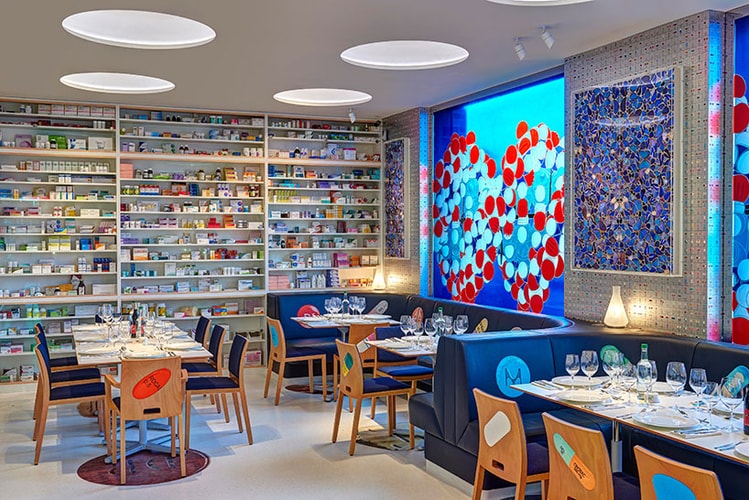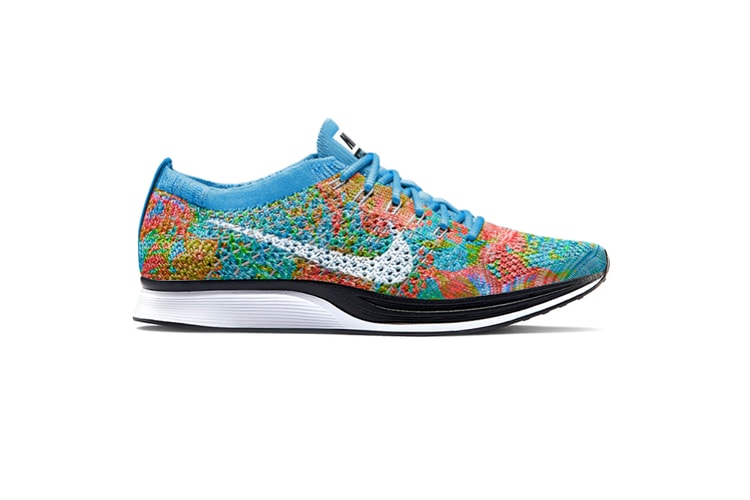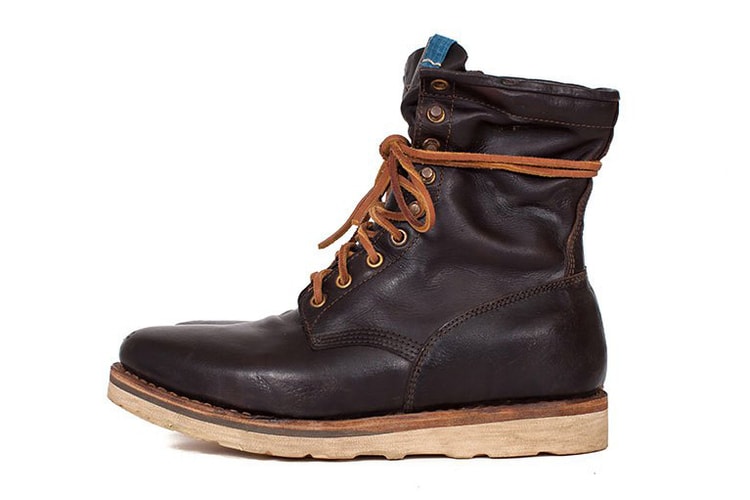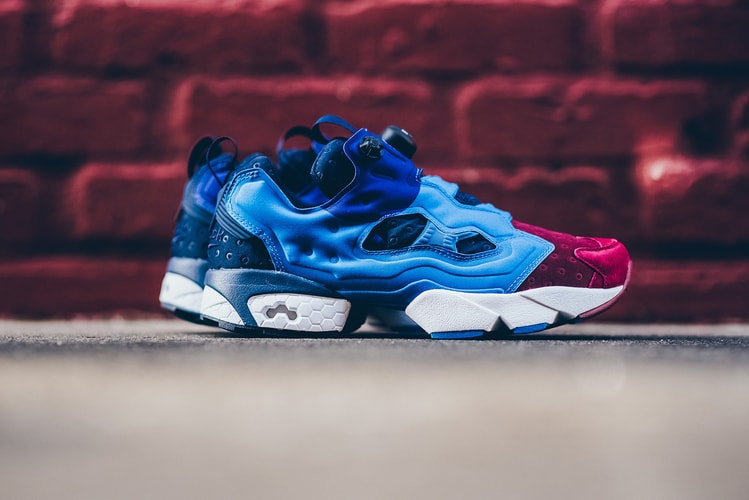Introducing Hiroki Nakamura the Collector
Picking the brain of visvim’s founder.

There is no denying that I have inherited the collector’s gene prevalent in my family. Over a period of many decades, my great uncle accumulated not only an extensive collection of expressionist art but also anything and everything that he and his wife came across during their excursions to all corners of the globe. My grandmother did the same on a smaller scale, and my parents are equally active collectors, so it is not surprising that I am active in building an archive of my own “stuff.” As for all of us, I believe that it is the stories connected to these things that we find enchanting.
They prevent us from letting go – the memories of a holiday trip, a nice day spent exploring a city, or the moment of a great, unexpected find. In a way, these objects also inspire and remind us of past experiences, motivating us to make new ones. One person with many such stories to tell is visvim’s founder Hiroki Nakamura. Besides his extensive knowledge in the fields of ancient textiles and manufacturing techniques, as well as their modern alternatives, Hiroki has built an archive of artifacts spanning centuries and many different cultures. When I visited the visvim showroom in Paris – the brand was showing its Spring/Summer 2016 collection – I was greeted by an almost museum-like setup, with multiple panels showing a small fraction of the vintage clothing, accessories, illustrations and artifacts that Hiroki has collected so far. They represent the creative sparks that lead him to designing and producing his collections. In the following interview, Hiroki tells us about his love for these objects, how they feed into his design philosophy, as well as shed light on a few of the anecdotes connected to his finds. When listening to Hiroki and looking at the scope of his work, one wonders if there are clone versions of Hiroki roaming the planet, which says a lot about his amazing team who play an essential role in making all of it happen.

How do you explain your fascination with vintage objects and artifacts?
Obviously, things in the past weren’t made for commercial reasons. I discovered that these objects are so much more powerful because they were designed for a purpose. They have so much more power and that speaks to me. I enjoy having them around me. They inspire me and I want to make things that have meaning for myself. If something is made for a reason, not just to be sold, it has a stronger feeling to me.
Since I was little, I have been collecting vintage stuff. I go to flea markets or vintage shops and I get strong feelings from these places and items.
When I started my own brand, I wanted to know how I could make products similar to objects that I get these feelings from. It is interesting to me and kind of my project to find out why.
The objects that you collect are mostly things that people throw away. Why do you think people discard these things?
I have five suitcases that I travel with and sometimes at customs and immigration they stop me and ask me to open them. And when I open the suitcases, there are a bunch of old clothes from the 18th century. These items are like treasure to me but for someone else they are trash.
I find it really nice to be surrounded by all of these objects that have meaning – they have a special value to me, rather than just a product for sale. Even rugs or Indian moccasins are things I have a lot of love for. It is something I enjoy, get inspired by and hopefully I can make something that gives similar love to other people.
And for later generations?
The jeans I’m wearing, for example, are made from denim that I recently developed, called “dry denim.” It is a cotton that I got from Okayama, but I’m inspired by vintage denim from the U.S. In Japan, there are so many manufacturers that are making similar “vintage-style” products, but I wasn’t satisfied when I compared them to the authentic materials. I wanted to know why – aside from not being able to achieve the same feeling through modern production techniques.
I use a special treatment to take out all of the moisture and oil from the cotton. So when you touch the fabric it feels really dry. Old denim from the ‘50s or ‘60s, which I love, has been washed with strong American washing machines and dried over 2,000 times.The California sun also keeps the denim extremely dry.
As for the denim we developed, my size is 34, but we actually sew them as a size 42 before shrinking it through a treatment which takes out all the moisture. You cannot control the procedure because the shrinkage is so great.
Why do you think people used to keep things for much longer than we do today?
Back then people thought the life cycle of a product was much longer. I don’t think they had the concept of throwing things away easily. They passed things down to the next generation; even I wore my sister’s denim. I was born in 1971, and it was normal.
I didn’t want to but my mother and my grandmother said “you should wear them.” But now, everything is disposable. Even a camera. When you bring it to the shop, they can’t fix it. I like old cars because I can fix them. I want to live with an object for a long time that gives me joy. I’m not denying modern technology or modern products, but I still enjoy the old way of life too. So I am taking advantage of both.

Where do you get these items from?
While I travel, for instance, when I’m here [Paris, France], in Munich [Germany], or on the West Coast [U.S.] where I spend most of my time. In Japan, I often go to the flea market in Kyoto, the old city, but I also take advantage of modern technology – eBay. The internet is the best! For example, I’ve worked on my motorcycle project for six months – a 1928 Indian Chief. I can’t imagine doing it without the internet. That would have probably been a lifelong project.
And even with what we’re doing here, this [visvim] production, sales, my lifestyle, without modern technology…forget it. We couldn’t do it. But I’m really interested in how I can use modern technology to tweak our lifestyle. It doesn’t have to be disposable. I can still enjoy these kinds of products, this type of production, and design process. I really appreciate modern technology.
There are different approaches towards vintage objects. As with your motorcycle, I remember you mentioning that you’d like to keep it like you found it.
I want to restore it so I can ride it. I’m also really charmed by the fact that it was customized by an individual, giving these things character and a personal touch.
I do make stuff and I do know a lot about modern manufacturing, which is one of my challenges – to add a personal feeling to the individual product through modern manufacturing processes. So that’s why we use natural dyes instead of industrial ones. People get attached to unique, individual products. For example, there is live bacteria in indigo that adds character to each product. I’m mixing modern technologies and processes with traditional methods to make something unique.
Your personal touch?
Only that I can’t touch every single product but the bacteria can [laughs].
I was surprised to see the graphics on the current T-shirts drawn by hand by this incredible artist…
Yes! I do use programs like Illustrator. But when using the computer, I don’t want to take advantage of reducing my work. I can still draw everything by hand, scan it and send it from California to Tokyo on the same day. That’s taking advantage of modern technology. But I still have to draw it. I don’t use copy and paste.
Sending my drawings from California to Japan used to take days, but now I can send the files digitally and they arrive almost at the same time. I think it is very important for a creative to choose how he is going to use technology. Again, I really appreciate modern technology. I really think we need it. But how we are using it and how we are approaching the process to make something is key.
You have a lot to tell, a lot of stories to the items that you collect. They’re all out there. Do you write them down?
[Laughs] No, I don’t. But I am showing the things on the boards here in Paris [at the showroom decorated with multiple panels of artifacts that build the inspirational basis for the upcoming visvim collection on display – Spring/Summer 2016]. For this collection, I wanted to share the objects, both modern and vintage pieces, as well as my sketches to show where I get my inspiration and how it is related to the output. By showing these processes, our supporters and customers can enjoy our products more.

Do you put a lot of these vintage objects, pieces of furniture, and displays in your shops?
Yes, like the fixtures in this showroom. Nine years ago in New York, I found a whole set of fixtures from a menswear boutique. They were open to selling them to me. They were so big that I had to use two 40-foot containers to ship them from New York to Japan. They were made during 1915 and were in perfect condition. In fact, these rotating fixtures inspired these fixtures here in Paris. The mechanism was patented in Germany and are really well-made from iron-cast and worked perfectly. They are double the height of the ones we have here. At the time, I thought “wow, I have never seen anything like this,” and was wondering why no one used these fixtures in clothing shops today. I wanted to restore them but I had no idea when I was actually going to use them. So I sent them to Tokyo by boat and people thought I was out of my mind because it was so expensive just to ship them. Buying the fixtures wasn’t expensive, but the shipping…
I also found a safe in the building, an old American safe from the 1800s, similar to what you see in cowboy movies. It was gigantic but I didn’t think about how heavy it was. I thought Ok, I’ll buy the safe. The price was OK but bringing it from the fourth floor down to the ground floor was a whole different story.
This safe weighed two tons. I still can’t find a space for it because it’s too heavy for modern buildings. We also bought this piece of furniture nine years ago and started restoring it with a Japanese carpenter. Now, we put these displays into our store because I like to use them. They are usable. Yes, some people say “they aren’t smooth,” but they still work fine. They are beautiful and they are made better than modern fixtures. I think this is inspiring.
If you took all of the products out of your shop, there would still be a lot to look at – the furniture and the objects. Is there a reason for this?
It is a commitment to myself to make a strong product, strong enough that it can compete with the furniture. If I make a product that doesn’t have a strong feeling, I think it would be unbalanced. The furniture is handmade by craftsmen, and if the product isn’t made to the same standards, then it is out of balance.
Well the furniture is from a time where the products were made by hand so it makes sense that it’s high quality.
It is a good reminder that we have to make nice products that last a long time.
Out of interest, why did you want the safe in the first place?
It is important for me to train myself not to think with my head but with my heart. For example, when I saw this umbrella some five years ago in New York, I didn’t think. My reaction was more like, “Wow.” I wondered “where does this ‘wow’ come from?” It comes from down here [points to heart]. It wasn’t expensive and I thought I’m going to use it. I didn’t know the story about it but for me, it is very important to have this “wow” feeling. Once I have that feeling, then I will start to analyze where it comes from. What makes me feel like that? Why is this umbrella “wow?” There is no brand name, no explanation, no one said anything but this is “wow.” I’m trying to put that “wow” into my product. So that’s what I like and that’s what I do.
How does Japan come in to this, because it seemed for a while that you were focused on North America?
For Spring/Summer 2011, I did a Japanese theme for the first time. I grew up in Japan but sometimes I was too close to my own culture. I couldn’t listen to here [points to heart] as there was too much information in my head. I liked the Japanese style but I wasn’t sure. I thought, “Does it look like my uncle, does it look like my grandfather – does it look too close?” But then I thought, “OK, I have to come up with a new approach.” If I listen to my heart, how can I make it look different enough for Japan – because I have Japanese supporters. For supporters overseas it would be easier but it was key for me to tweak it, but not too much. There is a fine line and when I found that line, I thought, “I can do this.”
Since I was 17, I traveled outside of Japan. I traveled and traveled and found good stuff, but i’ve always wanted to do something Japanese somehow. In 2011, I was ready to do it. A lot of inspiration always came from Japan like indigo, denim, worker’s clothing and old sashiko techniques, and so since then – our first collection in 2011 – our supporters in Japan started to also like it. They had no hesitation –– they do ‘kimono,’ and have lost the old preconception that they might look like their grandfather or uncle. So now I think, “No more” [laughs].
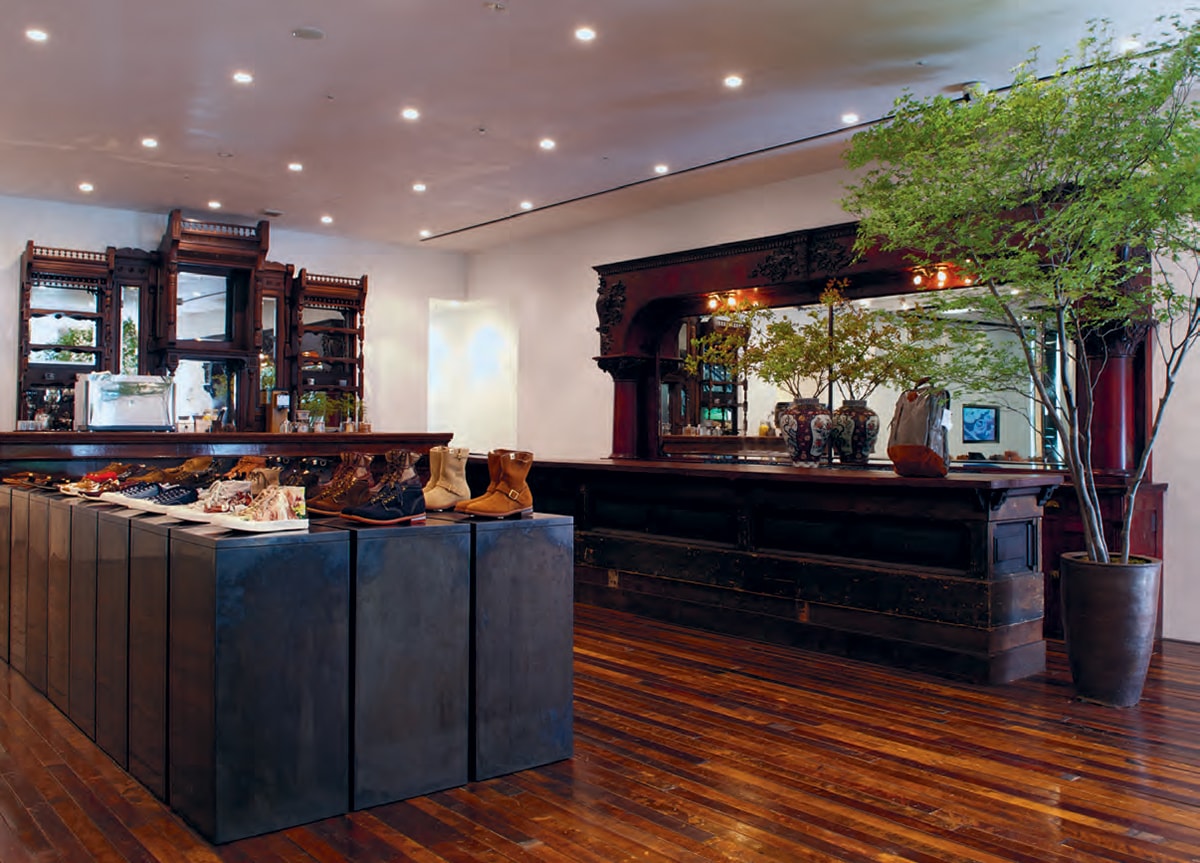
Is there a difference between how people value vintage items in Japan, the U.S., or Europe?
Yes, as I said, if people are too close, they take it for granted. They don’t think it is so important. Sometimes I go to the flea market in Kyoto and there is a bowl that’s 200 years old for $5 USD. If you found something like that in America, it would probably be at least $200 USD.
And you have the same vice versa within the U.S. and Europe?
Japan, Germany and even Italy have a lot of history, you see a lot of old stuff – people have somehow lost the perspective of how old these things are. That’s what I feel.
For me, it is important to listen to my heart. Sometimes when speaking to a vintage antique dealer, they persuade me to purchase the item saying that the product is from the Victorian era or Navajo. I listen to them, but it’s more important to listen to my heart.
How do you divide your finds between your personal collection and putting something in a showroom?
It is very hard. My wife is also into vintage stuff and she likes to decorate our home with pieces from the collection. The next day I’ll be like, “Can I take this for the office” or “can I take this to the shop?” So for me, if I’m excited, I believe that my team and supporters will get excited. This is what I do, and this is my life. That is why I’d like to share my excitement with my team and supporters.
What are some of your highlights?
The furniture for the visvim store – that is a project that spans over eight to nine years. I bought the furniture and shipped it over from New York. I rented a warehouse in the suburbs of Tokyo and hired a full-time carpenter to work on restoring it. When we found the new store on Omotesando, which opened last June, I knew this is the place I want to use it for. I’m quite happy with those fixtures and also the floor – we use salvaged wooden flooring from the United States.
How did you find that?
[Laughs] By accident, through the carpenter that I have been working with since the beginning. He actually based the fixtures in the showroom on the furniture I found in New York. I was really excited back then, and when I showed him these pieces, he also got excited. I told him that I wanted to make something now and show it in Paris. What you see here [displays in the showroom] is his work. Mr. Fukatsu unfortunately passed away five years ago, but his son is working for us now and took over his dad’s project and finished the restoration for the fixtures.
A while back, his father called me and said, “My son went into this church next to his kindergarten, and they said they are going to tear it down. Mr. Nakamura, are you interested in this wooden floor?” I said “yes, I’m coming today” [laughs]. That was probably six or seven years ago. I was like, “OK, I’m going to buy it and then donate some money to the church.”
So was there ever a moment when there was something that you couldn’t get because it was just too expensive or too difficult to ship maybe, or is there something that you’re still looking for?
Yeah, you know I’m always looking for inspiration. It could be a wooden floor, a wooden pole, fixtures, clothing, or textiles. Textiles are my passion now. I learned so much from old textiles, but sometimes on eBay, I might find something that I want and I will chat with my wife and tell her, “I really want this, I can use it for work.” And then sometimes I will miss it because it is eBay and I get outbid.
But you can always say to your wife that you need it for work.
[Laughs] Yes, but when I miss out on some items, I will say to my wife, “Oh damn, I missed that, I really wanted that.” She usually replies with “maybe it is not for you. Maybe it is meant for someone else.” And I agree with that. I mean there is enough in the world for everybody.

As you said, there’s so much in the world. Do you see an end or do you think it is endless?
I really like getting inspired, and I want to see more. Vintage items are the result; the output of the past. And there has been so much output… Of course among these vintage things, there is stuff that doesn’t speak to me. There are so many more options out there that it is virtually limitless.
So do you get rid of things? Like daily things or also some of your collection pieces?
I don’t mind using things and I also want to share them. If I use a textile for my store as decoration, it sometimes gets damaged [points to vintage oriental rug on floor]. Everybody in this room can enjoy these textiles. Even I use it, and if it is damaged, I will fix it. Sometimes, I give things to people who can appreciate them.
Earlier you said your inspiration and motivation is to create products that have meaning. What do you think will happen to the products that you make? Do you think they will be found?
I get a lot of joy from products. I like old, vintage clothing, but I really enjoy wearing my own clothing. If it is how I want it to be and how I want it to look, for me, it is important that I can enjoy it.
If in a hundred years’ time, someone finds a jacket made by visvim that’s based on a jacket from the 19th century, what do you think people would think? Would it be strange to them?
Let me show you something [we walk through the showroom to look at one of the display panels that hold several artifacts. In this case is a wooden box with studs, Native American Indian medicine bags and belts, and 19th and mid-20th century cowboy belts].
This is a really cool story my friend from New York told me and I’d like to share it with you. It is about this box. When the first settlers, Europeans, came to the American continent, they arrived in the East and then crossed the continent. They kept their nice jewelry and important documents in a box, a treasure box. And, of course, they came across Indians. For the Indians, this box and the papers inside it didn’t mean anything. But they wanted to have the rivets [that the boxes were decorated with]. When they saw the rivets they thought, “That’s the coolest stuff we’ve ever seen!” [Hiroki points to a pamphlet depicting a number of illustrations of Indian Chiefs] These Chiefs wanted to get love and attention from girls and other people so they decided to put these rivets from the box – conchos – onto their belts. This is another example [Hiroki holds up a bag]. It is a medicine bag from the 1830s, and when you look at it, it is so beautiful. This is an original box that the settlers brought to America, and similar to the belt, the rivets from the box were turned into embellishments for this bag.
And then the cowboys, who were also going towards the West to hunt buffalo, saw the Indians and thought “wow, those Chiefs are so good looking – I want to get that.” They also wanted to get attention from girls and so they decided to make their own version by putting the conchos on their belts. So this is a cowboy belt from around 1900s [holds it up] and these concho belts became really popular among cowboys. And this is a 1950s belt [holds it up] which became a special part of menswear during that time.
So, as you see it is so interesting to see and learn about the inspiration behind things. The motivation for the Indians and cowboys was to get love, to make themselves look good. It took probably 200 years, but it came from a box to cowboy belts. Do you see what I am getting at? The influence carries on – it changes slowly. When you make something, it is very important to understand where it comes from. For me, when I saw these items, I didn’t know the story or how it came from one another, but the design I thought was so strong.
So when getting inspiration from something old – and for all of us getting inspiration from anything, I don’t mind having any young designer get inspiration from my product – the key for me is to push my product from here [box] to here [concho-decorated cowboy belts]. And if the final product is going to be a new standard, ta-da! I did something.
[We walk over to another panel that holds several pairs of vintage Native American moccasins]
And hopefully this [points to a vintage pair of moccasins] will be my new standard [shows the redesigned FBT Moccasin for Spring/Summer 2016].
Hopefully someone will find this story, this interview, in which you tell your story. Because I don’t think the cowboys knew anything about those boxes.
No. Someone might get inspired by this and won’t know anything about the origin. It goes on and it is OK that you get inspired by other things. The key is how you want to push your product and make something new – a new standard. Only time will tell. If my jacket is not good enough, then it will not set a new standard.
… And it might not end up in a vintage store in New York in 150 years?
[Laughs]



